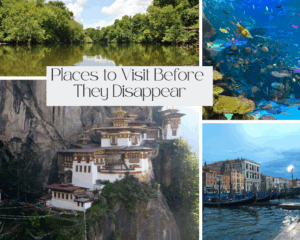
Are you planning a trip to Iceland in October and want to learn all about the weather and the best things to do?
Well, the first thing you should know is that October really is one of the best months to visit Iceland!
This month marks the transition from summer to winter, which means the end of high season and as a result, you can expect fewer crowds and better prices.
While the weather in Iceland in October (and throughout the year) can be unpredictable, it generally offers milder conditions. It’s not extremely cold yet, and the longer dark nights create an ideal opportunity to witness the Northern Lights.
In this guide, I will share everything you need to know about visiting Iceland in October. What is the fall weather like? What are the top activities to experience? You’ll find practical tips for everything from road trips to what to pack for your trip.
Consider this your ultimate guide to visiting Iceland in October!
Weather In Iceland in October
If you ask a beach town girl like me, Iceland in October is very cold! But in reality, October isn’t too harsh yet, making it a great time to visit.
You can expect average temperatures to range from about 2 °C to 7 °C (36 °F to 45 °F). However, with the wind and other factors, it can feel more like -3 to 0 °C (27 to 32 °F). You might also encounter a mix of rain and even a bit of snow.
The truth is, Icelandic weather is super unpredictable and can change in a heartbeat. So no matter what, be sure to pack those warm layers!
How many daylight hours are there?
Iceland in October enjoys about 8 to 12 hours of daylight, depending on the time of the month. As the month progresses, you’ll notice the days getting shorter, but it’s still enough time to explore and soak in the sights! Just be ready for those stunning sunrises and sunsets!
Does it snow in Iceland in October?
Yes, it can snow in Iceland in October! While it’s not guaranteed, especially early in the month, you might see some light snow, especially in the northern regions and higher elevations.
How much rain does Iceland get in October?
In October, Iceland typically experiences about 70 to 100 mm (2.8 to 4 inches) of rainfall. It’s one of the wetter months, especially in the more coastal areas. So, while you might enjoy some beautiful autumn scenery, definitely be sure to pack a waterproof jacket and sturdy shoes for your adventures.
Can you see Iceland’s Northern Lights in October?
Yes, you can certainly see Iceland’s Northern Lights in October! Some people even say this is the best month to catch this stunning phenomenon. I’m not sure about that, but I can tell you that we saw them a few times, and the displays were absolutely spectacular!
If you’re on the hunt for auroras, keep in mind that clear skies are key for the best views. Websites like Aurorareach.com provide real-time aurora maps, so get in hunting mode and track these beauties down!
What to pack for Iceland in October

Clothing:








Accessories:






Events and Festivals in Iceland in October
One of the highlights of October in Iceland is the Reykjavík International Film Festival (RIFF), a special event that draws filmmakers and movie buffs from around the world. The 11-day event features a wide array of activities, including film screenings, documentaries, workshops, and discussion panels.
October also brings the opportunity to witness the Lighting of the Imagine Peace Tower, a tribute to John Lennon, held on his birthday, October 9th. Yoko Ono’s memorial to Lennon is an annual tradition that projects a light pillar up to 4 kilometers into the sky.
Other activities to look out for include Halloween in late October, and for those who enjoy music, there are often small concerts happening throughout Reykjavík.
Best Things to Do in Iceland in October
There are so many amazing things to do and see in Iceland in October. The best way to experience everything Iceland has to offer is by renting a car or RV and hitting the road.
October is a wonderful time for this, as you can soak in the beautiful orange, yellow, and green hues of autumn. While the weather can be a bit unpredictable, and might require a bit of flexibility from your side, you can still explore and discover all the breathtaking landscapes and attractions during this month.
And since October is a shoulder month, you’ll find that many attractions and tours have better availability. This means you won’t have to book everything far in advance, and you can avoid those pricey peak-season costs.
Things like tours, attractions, accommodations, and car or RV rentals are generally cheaper than in the summer. Considering that prices in Iceland can be a bit high, this is definitely a bonus!
Here are the best things to do in Iceland in October:
Road Trip: The Golden Circle / Ring Road

October is a great time to hit the road in Iceland. There are a few routes to explore, but the most common ones are the Golden Circle and the Ring Road.
The Golden Circle is a great option is if you have limited time. This loop can be done from Reykjavík and covers 3 famous attraction sites: Thingvellir National Park, the Geysir geothermal area, and the Gullfoss waterfall. You can cover everything in one day, but if you have the time, consider an overnight stay to fully enjoy the natural beauty and stop by at in-between attractions. Think Icelandic horse farms, local restaurants, and stunning Lutheran churches!
For those with more time, seven days or more, the Ring Road is the best route to experience a full loop of the country. The route circles the entire island, and allows you to reach all the main attractions. This route will take you through diverse and truly stunning landscapes.
Must-see attractions along the Ring Road:








While road conditions are generally good, specially in early October, it’s always a good idea to rent a 4×4 vehicle because of Iceland’s strong winds and sudden weather changes. By the end of October, snow may already be falling in the northern parts, making a 4×4 essential.
I did a 10-day Ring Road, and it was phenomenal! We were really lucky with the weather, so we had no delays or issues. However, it’s important to be flexible and be prepared for bad weather just in case.
The most crucial factor to consider and to check when driving in Iceland is the wind. The official site of the Icelandic Meteorological Office, Vedur.is, provides a real time weather forecast with updates on wind speed and direction, temperatures, and other important weather information.
Traveling as a group? Check out my guide on “How to split travel expenses with friends and family“ and ensure a seamless and stress-free trip!
Watch the Northern Lights

The Northern lights are only visible when the sky is dark and clear, so it’s impossible to catch them from May to September because of the midnight sun. But October is one of the best months to catch the aurora borealis, with nights lasting up to 11–13 hours.
If you aren’t road-tripping around Iceland, a guided Northern Lights tour is a great way to experience this stunning phenomenon, as guides will take you to the best spots for clear skies. If you have your own car or camper, you can download an Aurora forecast app or check Iceland’s Northern Lights tracker to find the best viewing locations yourself.
Tip: While the aurora borealis can never be guaranteed, your best chance is to head to areas with minimal artificial lights, like Thingvellir National Park or the Snæfellsnes Peninsula. City parks like Klambratuh and Laugardalur also offer great views of the Northern lights.
On our 10-day road trip, we were lucky enough to catch the auroras at least four times. Many of the campsites were in remote locations, offering the perfect backdrop to fully appreciate them. Other times, we chased them down using tracking apps and websites.
Whale Watching
October is the end of summer, so all the animals, including whales and puffins, are migrating for winter. While puffins are no longer visible during this month, there are still opportunities to spot whales.
Many marine animals remain along the coasts during this time, and the relatively warmer waters of October offer opportunities for sightings. To get the best chance to see these animals, you should start your whale-watching tour from Reykjavik or Húsavík in the north. Tours generally take around 3 hours. And, in addition to humpback whales, you might also spot blue whales, minke whales, and even orcas.
But be sure to wear thick and warm clothing, as the boat tours can get very chilly!
Visit an Ice Cave

One of the best things to do in Iceland in October is to visit the stunning ice caves. Though they are typically more accessible during the winter months, some ice caves in the Vatnajökull glacier run from early October to March. The best thing about these caves is that they change as the glaciers shift, making every visit a unique experience.
Since the caves can only be explored with a guided tour, it’s best to book one before your trip. We joined Ice Pic Journeys. Their tours run multiple times a day, but I highly recommend you opt for the early bird tour, which is at 8AM, this way you can avoid the crowds. The space inside the caves is very limited, so it gets pretty crowded fast, making it hard to take pictures.
The tour includes all the necessary gear to access the caves, including everything you need to hike the glacier—an adventure in itself! Vatnajökull, the largest glacier in Europe, offers breathtaking views that you won’t want to miss!
Horse Riding
Iceland’s breed of horse, the Icelandic horse, is world-renowned and one of the most cherished creatures in the country. Riding these sturdy and friendly horses is an experience unique to Iceland.
Thousands of years ago, these horses were brought to the country and developed some special traits to help them survive in Iceland’s harsh weather conditions. Horseback riding is also one of the best ways to explore Iceland’s countryside and its rugged landscapes, especially during the shoulder month of October when there are fewer crowds. Many tours take you through lava fields, black sand beaches, and stunning valleys.
Discover Iceland’s Untouched Nature with a Glacier Hiking Tour

Iceland is a playground for adventure seekers who want to admire and hike the stunning glacier lagoons. With clearer skies and fewer tourists, it’s a perfect time to experience glaciers like Vatnajökull or Sólheimajökull where you get to walk on an endless stretch of ice.
Whether you’re a beginner or a seasoned pro, there are various hike options available, with different locations, durations, and difficulty levels. Each tour includes all the necessary equipment, along with knowledgeable guides who will lead the way and help you gain a deeper understanding of the glaciers.
Along the way, you’ll take in breathtaking views and have plenty of photo opportunities to capture those stunning moments! So, if you’re looking for a unique adventure, consider joining a glacier hiking tour, it’s a fantastic way to experience untouched nature in a safe way.
Snorkel and Dive Between Continents
Yes, you can snorkel and dive in Iceland in October! Snorkeling and diving are popular activities in Iceland throughout the year, and October is a great time to experience them before the harsh winter temperatures arrive. While the water is cold (around 2-4 °C or 36-39 °F), it’s also very clear, offering visibility of over 100 meters.
While there are many places around Iceland to snorkel and dive, Silfra Fissure is the best place. Silfra Fissure is located in Thingvellir National Park, a natural wonder created as the North American and Eurasian tectonic plates drifted apart. So you can swim between two continents!
Natural Hot Springs

Iceland is famously known for its natural hot springs, with places like the Blue Lagoon and Sky Lagoon gaining world-renowned status (and for good reason!). Both are conveniently located near Reykjavík, making them perfect for a quick visit even if you’re short on time.
We opted to visit Sky Lagoon after a local recommended it as a less touristy alternative with a better experience. I can’t recommend it enough—it was truly exceptional!
Relaxing in a hot spring is a favorite Icelandic pastime and a great way to unwind after a day of hiking or road-tripping. Especially with the chilly weather, jumping into the naturally warm waters feels incredible!
You’ll find many options across the country. We also took the time to visit other local springs, Myvatn Nature Baths in the north and Reykjadalur Hot Springs, which requires a hike to reach the river. Other popular spots include Secret Lagoon and Laugarvatn Fontana geothermal baths, which are perfect for when you’re exploring the Golden Circle. Just keep in mind that for some local spots, you’ll have to brave the cold and walk outside in your bathing suit to get inside.
Hiking in Iceland in October

Though it’s not the height of summer, hiking in Iceland in October is still possible! You’ll be able to enjoy this beautiful outdoor activity with fewer tourists on the trails. Multi-day hikes might not be an option from the beginning of October because it’s too cold for camping, but you can opt for one of the many single-day trips.
Thingvellir National Park is home to some of the country’s most iconic hikes, and the Skaftafell Nature Reserve in the southeast offers some of the best autumn scenery, with glacier views and waterfalls like Svartifoss. Another iconic region for hiking is Landmannalaugar, with its rhyolite mountains and natural hot springs that you can access on tours.
Sightseeing in Reykjavik

Reykjavík, Iceland’s capital, is full of Nordic charm. It has a cozy downtown area, fantastic restaurants, tons of museums, and a surprisingly lively nightlife. One of my favorite things to do here was simply stroll through the streets lined with cute, colorful houses. (Technically, they’re a mix of houses and buildings, but either way, the vibrant colors and pointy rooftops give the city a unique, postcard-worthy look). If you’re into history and culture, you can opt to join one of the many walking tours.
Other things to do in Reykjavík include visiting the famous Hallgrímskirkja church and exploring various museums. Popular options include the National Museum of Iceland, Whales of Iceland, and Perlan Museum, but there are many more choices, so be sure to do your research in advance! And, for a truly unique experience, consider attending the Lava Show.
Lastly, don’t forget to indulge in some local cuisine. A popular local café is Café Loki, where we tried some delicious lamb and the controversial (for its taste) fermented shark. For a special dinner, visit Grillmarkaðurinn, a beautiful restaurant with dishes that will blow your mind, including whale, puffin, reindeer, and horse!
Last Words…
With the weather transitioning from summer to winter and autumn painting the landscape in vibrant hues, October is a stunning time for an Iceland trip. Whether you’re here to chase the Northern Lights, embark on outdoor adventures, or soak in the relaxing hot springs, you’ll find plenty of activities to fill your itinerary and your heart.
Don’t forget to pack warm clothes, go with a tour guide when necessary, and prepare for a beautiful experience in the land of fire and ice!







